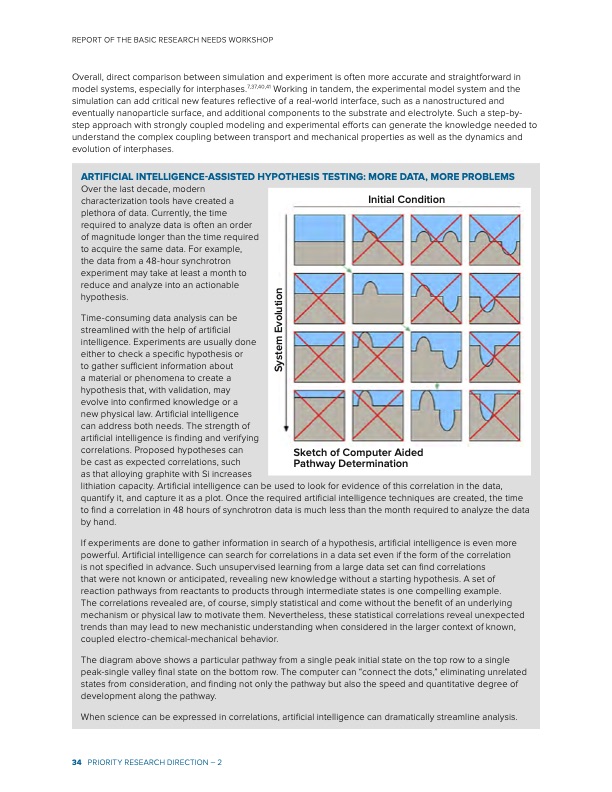
PDF Publication Title:
Text from PDF Page: 040
REPORT OF THE BASIC RESEARCH NEEDS WORKSHOP Overall, direct comparison between simulation and experiment is often more accurate and straightforward in model systems, especially for interphases.7,37,40,41 Working in tandem, the experimental model system and the simulation can add critical new features reflective of a real-world interface, such as a nanostructured and eventually nanoparticle surface, and additional components to the substrate and electrolyte. Such a step-by- step approach with strongly coupled modeling and experimental efforts can generate the knowledge needed to understand the complex coupling between transport and mechanical properties as well as the dynamics and evolution of interphases. ARTIFICIAL INTELLIGENCE-ASSISTED HYPOTHESIS TESTING: MORE DATA, MORE PROBLEMS Over the last decade, modern characterization tools have created a plethora of data. Currently, the time required to analyze data is often an order of magnitude longer than the time required to acquire the same data. For example, the data from a 48-hour synchrotron experiment may take at least a month to reduce and analyze into an actionable hypothesis. Time-consuming data analysis can be streamlined with the help of artificial intelligence. Experiments are usually done either to check a specific hypothesis or to gather sufficient information about a material or phenomena to create a hypothesis that, with validation, may evolve into confirmed knowledge or a new physical law. Artificial intelligence can address both needs. The strength of artificial intelligence is finding and verifying correlations. Proposed hypotheses can be cast as expected correlations, such as that alloying graphite with Si increases lithiation capacity. Artificial intelligence can be used to look for evidence of this correlation in the data, quantify it, and capture it as a plot. Once the required artificial intelligence techniques are created, the time to find a correlation in 48 hours of synchrotron data is much less than the month required to analyze the data by hand. If experiments are done to gather information in search of a hypothesis, artificial intelligence is even more powerful. Artificial intelligence can search for correlations in a data set even if the form of the correlation is not specified in advance. Such unsupervised learning from a large data set can find correlations that were not known or anticipated, revealing new knowledge without a starting hypothesis. A set of reaction pathways from reactants to products through intermediate states is one compelling example. The correlations revealed are, of course, simply statistical and come without the benefit of an underlying mechanism or physical law to motivate them. Nevertheless, these statistical correlations reveal unexpected trends than may lead to new mechanistic understanding when considered in the larger context of known, coupled electro-chemical-mechanical behavior. The diagram above shows a particular pathway from a single peak initial state on the top row to a single peak-single valley final state on the bottom row. The computer can “connect the dots,” eliminating unrelated states from consideration, and finding not only the pathway but also the speed and quantitative degree of development along the pathway. When science can be expressed in correlations, artificial intelligence can dramatically streamline analysis. Sketch of Computer Aided Pathway Determination Initial Condition 34 PRIORITY RESEARCH DIRECTION – 2 System EvolutionPDF Image | Next Generation Electrical Energy Storage

PDF Search Title:
Next Generation Electrical Energy StorageOriginal File Name Searched:
BRN-NGEES_rpt-low-res.pdfDIY PDF Search: Google It | Yahoo | Bing
Sulfur Deposition on Carbon Nanofibers using Supercritical CO2 Sulfur Deposition on Carbon Nanofibers using Supercritical CO2. Gamma sulfur also known as mother of pearl sulfur and nacreous sulfur... More Info
CO2 Organic Rankine Cycle Experimenter Platform The supercritical CO2 phase change system is both a heat pump and organic rankine cycle which can be used for those purposes and as a supercritical extractor for advanced subcritical and supercritical extraction technology. Uses include producing nanoparticles, precious metal CO2 extraction, lithium battery recycling, and other applications... More Info
| CONTACT TEL: 608-238-6001 Email: greg@infinityturbine.com | RSS | AMP |